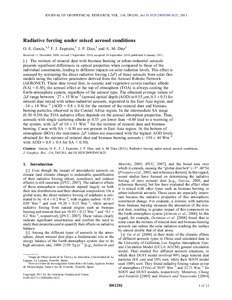Por favor, use este identificador para citar o enlazar este ítem:
http://hdl.handle.net/20.500.11765/2391
Radiative forcing under mixed aerosol conditions
Registro completo de metadatos
| Campo DC | Valor | Lengua/Idioma |
|---|---|---|
| dc.contributor.author | García Rodríguez, Omaira Elena | es_ES |
| dc.contributor.author | Expósito González, Francisco Javier | es_ES |
| dc.contributor.author | Díaz González, Juan Pedro | es_ES |
| dc.contributor.author | Díaz Rodríguez, Ana María | es_ES |
| dc.date.accessioned | 2016-05-06T08:40:44Z | - |
| dc.date.available | 2016-05-06T08:40:44Z | - |
| dc.date.issued | 2011 | - |
| dc.identifier.citation | Journal of Geophysical Research: Atmospheres. 2011, 116(D1), p. D01201 | es_ES |
| dc.identifier.issn | 2169-897X | - |
| dc.identifier.issn | 2169-8996 | - |
| dc.identifier.uri | http://hdl.handle.net/20.500.11765/2391 | - |
| dc.description.abstract | The mixture of mineral dust with biomass burning or urban-industrial aerosols presents significant differences in optical properties when compared to those of the individual constituents, leading to different impacts on solar radiation levels. This effect is assessed by estimating the direct radiative forcing (ΔF) of these aerosols from solar flux models using the radiative parameters derived from the Aerosol Robotic Network (AERONET). These data reveal that, in oceanic and vegetative covers (surface albedo (SA) < 0.30), the aerosol effect at the top of atmosphere (TOA) is always cooling the Earth-atmosphere system, regardless of the aerosol type. The obtained average values of ΔF range between −27 ± 15 Wm−2 (aerosol optical depth (AOD) at 0.55 μm, 0.3 ± 0.3) for mineral dust mixed with urban-industrial aerosols, registered in the East Asia region, and −34 ± 18 Wm−2 (AOD = 0.8 ± 0.4) for the mixture of the mineral dust and biomass burning particles, observed in the Central Africa region. In the intermediate SA range (0.30–0.50) the TOA radiative effect depends on the aerosol absorption properties. Thus, aerosols with single scattering albedo at 0.55 μm lower than ∼0.88 lead to a warming of the system, with ΔF of 10 ± 11 Wm−2 for the mixture of mineral dust and biomass burning. Cases with SA > 0.30 are not present in East Asia region. At the bottom of atmosphere (BOA) the maximum ΔF values are associated with the highest AOD levels obtained for the mixture of mineral dust and biomass burning aerosols (−130 ± 44 Wm−2 with AOD = 0.8 ± 0.4 for SA < 0.30). | es_ES |
| dc.description.sponsorship | Support for this study was given by Spanish Ministry of Education and Science, projects CGL2005‐03428‐C04‐02, CGL2007‐66477‐C02‐02/CLI, PI042005/033, and CGL2008‐04740/CLI. | - |
| dc.format | application/pdf | - |
| dc.language.iso | eng | es_ES |
| dc.publisher | American Geophysical Union | es_ES |
| dc.subject | Radiative forcing | es_ES |
| dc.subject | Atmospheric aerosols | es_ES |
| dc.title | Radiative forcing under mixed aerosol conditions | es_ES |
| dc.type | info:eu-repo/semantics/article | es_ES |
| dc.relation.publisherversion | https://dx.doi.org/10.1029/2009JD013625 | es_ES |
| dc.rights.accessRights | info:eu-repo/semantics/openAccess | es_ES |
| Colecciones: | Artículos científicos 2010-2014 | |
Ficheros en este ítem:
| Fichero | Descripción | Tamaño | Formato | ||
|---|---|---|---|---|---|
| Garcia_2011-JGRSE.pdf | 1,16 MB | Adobe PDF |  Visualizar/Abrir |
Los ítems de Arcimis están protegidos por una Licencia Creative Commons, salvo que se indique lo contrario.





